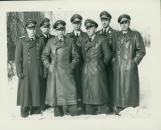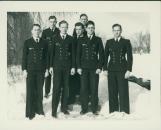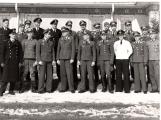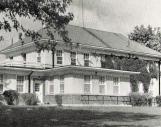2
The Establishment of Camp 30Some sources reported that the Bowmanville Training School was examined as a candidate for conversion to a Prisooner of War camp due in part to complaints made by German POWs who were interned at camp 100 in Neys, Ontario. In a desperate effort to be sheltered in accordance with the Geneva Conversation the POWs staged a hunger strike which lasted four days, so as to request the immediate visits of the Swiss Consul and the International Red Cross to investigate their complaints concerning the accomodation.
As a result of these complaints, more suitable accommodations was to be found.
The Toronto Star reported, as early as April 1941, the intended conversion of the Training School into an internment camp. The first recorded entry in Camp 30 War Diary is October 15, 1941. The first POWs arrived in Bowmanville on November 19th that same year. That planned conversion gave Canadian officials only seven months in which to make their many preparations.
Taken from "Camp 30 'Ehrenwort' A German Prisoner-of-War Camp in Bowmanville 1941-1945" by Daniel Hoffman 1988
3
The Geneva ConventionUnder the Geneva Convention, three important rights are guaranteed to prisoners of war:
1) That they will be fed and sheltered at the same standards as base or depot troops of the Capturing Power;
2) That they can send and recieve mail;
3) That they will be visited by delegates of the International Committee of the Red Cross (ICRC) who will report in secret their treatment to a Protecting Power.
4
The Toronto Star article in April 1941 worried local residents, as the article put it "the uncomfortable idea of having the enemy within our gate", and support grew for the Boys Training School. Several interest groups and individuals protested the close of the school noting that it was too good of a school to discontinue, and, on the other hand that the new proposed use might lead to depreciation of local farm values. Furthermore, it seemed to offer easy escape possibilites. However, the Department of National Defence, the Swiss Consul and the Red Cross had inspected and approved the property for its take-over as an internment camp.Taken from "Bowmanville / Another Farewell to Arms" by W. Anthony Norton 1981
8
An internment camp was foremost a military environment. Military structures governed relations between Canadian authorities and German prisoners of war. Both sides relied on the maintenance of military order and discipline for stability. Under the provisions of the 1929 Geneva Convention, German military leaders assumed considerable control over their own men. Consequently, the hierarchy, customs, and forms of the German armed forces continued to condition the lives of many German POWs.Taken from "German Prisoners of War in Canada and Their Artifacts 1940-1948" by C.M.V. Madsen and R.J. Henderson









